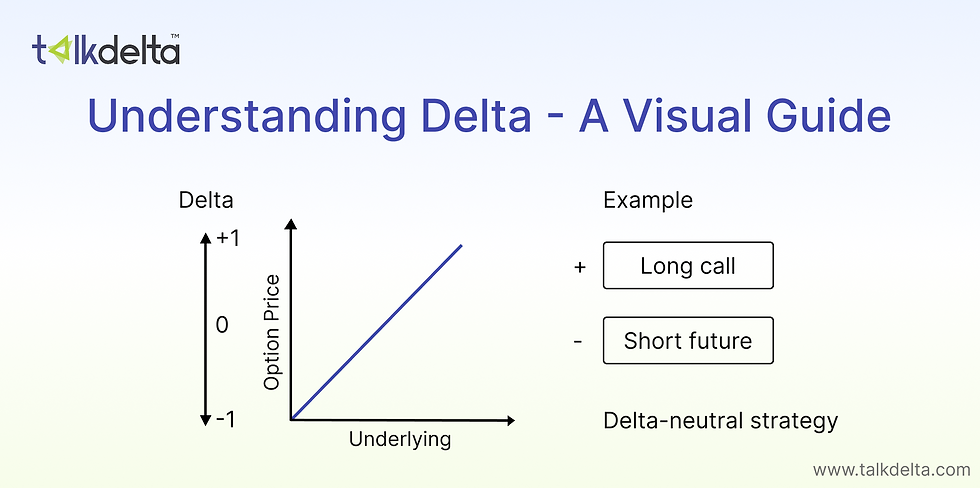Delta Hedging - Meaning & Strategies
- Rohit More
- Nov 8, 2021
- 3 min read
Updated: Nov 22, 2021

What is delta?
Delta represents the directional risk of a stock or option position. In the trading world, the term hedging refers to reducing risk. So putting these two terms together the Delta hedging is a practice of reducing directional or Delta risk. Delta hedging is a defensive tactic used to reduce the directional exposure of Stock or option position. Delta hedging is done by adding a position that brings the Position Delta closer to zero. So if you have a positive position Delta and you want to reduce that risk you have to add positions with negative Delta to bring that position Delta closer to zero and the opposite is true if you have a negative position Delta.
Delta is the rate at which premium changes based on the directional movement of an underlying asset. In options, delta is a measure of how sensitive the price of a particular option is to changes in the market price of the underlying asset. The price of the option here is its intrinsic value, i.e. the value of the option if it were executed at this point.
Call options have a delta in the positive. In CALL options, Delta is in the range of 0 to 1. Whereas, Put options commonly have a delta in the negative. In PUT options, Delta is in the range of 0 to -1
The delta of an in-the-money (ITM) option is over 0.5 while an at-the-money (ATM) option has a delta of 0.5 & an out-of-money (OTM) option has a delta of less than 0.5. With the change in the price of the underlying a given option could move from OTM and then to ATM before touching ITM, or vice-versa.
What is Delta hedging?
Delta hedging is frequently used by derivative dealers, and less often by retail investors to reduce or eliminate a portfolio’s exposure to an underlying. When you are delta hedging an option and want to make the position “delta neutral”, it means that you would no longer care what happens to your net position for small movements in the underlying.
A delta neutral position is the position in which the overall delta is zero, which minimizes the options’ price movements concerning the underlying asset.
For example, suppose an investor holds one call option with a delta of 0.50, which indicates the option is At-The-Money and wishes to maintain a delta neutral position. The investor could purchase an At-The-Money PUT option with a delta of -0.50 to offset the positive delta, which would make the position have a delta of zero.
To measure delta in options, traders don’t always use the same scale. Traders ues any one of the 0 to 1 scale and 0 to 100 scale. Hence, the 0.30 delta value on the scale of 0 to 1, is similar to 30 on the 0 to 100 scale.
Strategies for Delta Hedging
Following are potential strategies that you can use to reduce the directional or Delta risk of an existing position:
If Position Delta is Negative, hedge with these strategies:
Long Stock
Long Calls
Short Puts
Long Call Spreads
Short Put Spreads
If you have a position with negative deltas you're expected to lose money when the stock price increases and make money when the stock price Falls. So to hedge that position you need to add a strategy that profits when the stock price increases and loses money when the stock price decreases which will offset that existing position. So if you have a position with negative deltas you can hedge that position with long stock, long calls,short puts, long call spreads and short put spreads. Now all of those strategies are positive deltas of strategies which means if you implement them on top of a negative Delta strategy the overall directional risk of that position will decrease.
If Position Delta is Positive, hedge with these strategies:
Short Stock
Long Puts
Short Calls
Short Call Spreads
Long Put Spreads
You can use short stock, long put,short calls, short call spreads over long put spreads now all of those strategies have negative deltas which means if you implement those strategies on top of a positive Delta position the overall Delta of that position will decrease therefore have less directional risk.
Things to remember in Delta Hedging
Hedging is believed to be a low-risk strategy with very limited potential for both profits and losses. Hedging can be considered as a profitable strategy only if a trader is experienced and can make profitable trades by accounting for all the costs of trading without conceding to the pitfalls of a market.
The approximate value of Delta Hedge is accurate only within small ranges and as prices move sharply, the delta itself changes dramatically, Therefore, one of the primary things to do with delta hedging is the need to constantly watching and adjusting the positions involved. Depending on the movement of the stock, the trader has to frequently buy and sell securities to avoid being under hedged or over hedged.



Hempdelics is one of the best dispensaries in the United States that sells legal Psychedelic Products ! Whether you’re looking for a great trip or you’re ready to dive deeper into unlocking your mind, Hempdelics got you covered. We are Best in psychedelic mushrooms and microdosing mushrooms!
<a href="https://hempdelics.com/product/oneup-bars/" rel="dofollow">OneUp Bars</a>
<a href="https://hempdelics.com/product/5-meo-dmt/" rel="dofollow">5-MeO-DMT</a>
<a href="https://hempdelics.com/product/buy-ayahuasca/" rel="dofollow">Buy Ayahuasca</a>
<a href="https://hempdelics.com/product/psilocybin-capsules/" rel="dofollow">Psilocybin Capsules</a>
<a href="https://hempdelics.com/product/lsd-gel-tabs/" rel="dofollow">LSD Gel Tabs</a>
<a href="https://hempdelics.com/product/liquid-lsd/" rel="dofollow">Liquid LSD</a>
<a href="https://hempdelics.com/product/lsd-blotters/" rel="dofollow">LSD Blotters</a>
<a href="https://hempdelics.com/product/mdma-pills/" rel="dofollow">MDMA Pills</a>
<a href="https://hempdelics.com/product/lsd-gummies/" rel="dofollow">LSD Gummies</a>
<a href="https://hempdelics.com/product/buy-golden-teacher-cubensis/" rel="dofollow">Buy Golden Teacher Cubensis</a>
<a href="https://hempdelics.com/product/magic-mushroom-grow-kits/" rel="dofollow">Magic Mushroom Grow Kits</a>
<a href="https://hempdelics.com/product/arenal-volcano-cubensis/" rel="dofollow">Arenal Volcano Cubensis</a>
<a href="https://hempdelics.com/product/blue-meanies-cubensis/" rel="dofollow">Blue Meanies Cubensis</a>
<a href="https://hempdelics.com/product/penis-envy-magic-mushroom/" rel="dofollow">Penis Envy Magic Mushroom</a>
<a href="https://hempdelics.com/product/amazonian-cubensis/" rel="dofollow">Amazonian Cubensis</a>
<a href="https://hempdelics.com/product/b-cubensis/" rel="dofollow">B+ Cubensis</a>
<a…
nice poetry. http://www.arabic-poems.com